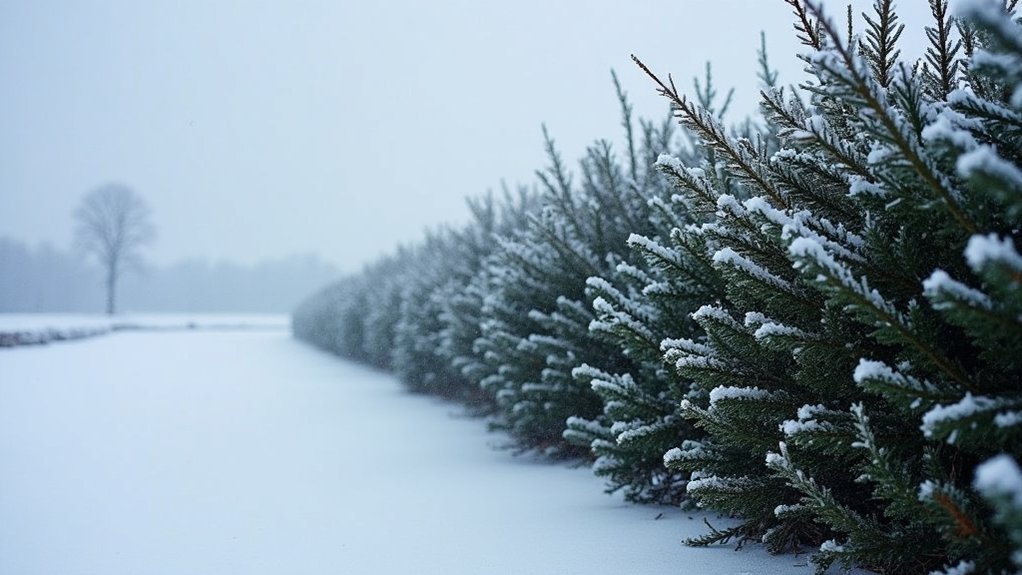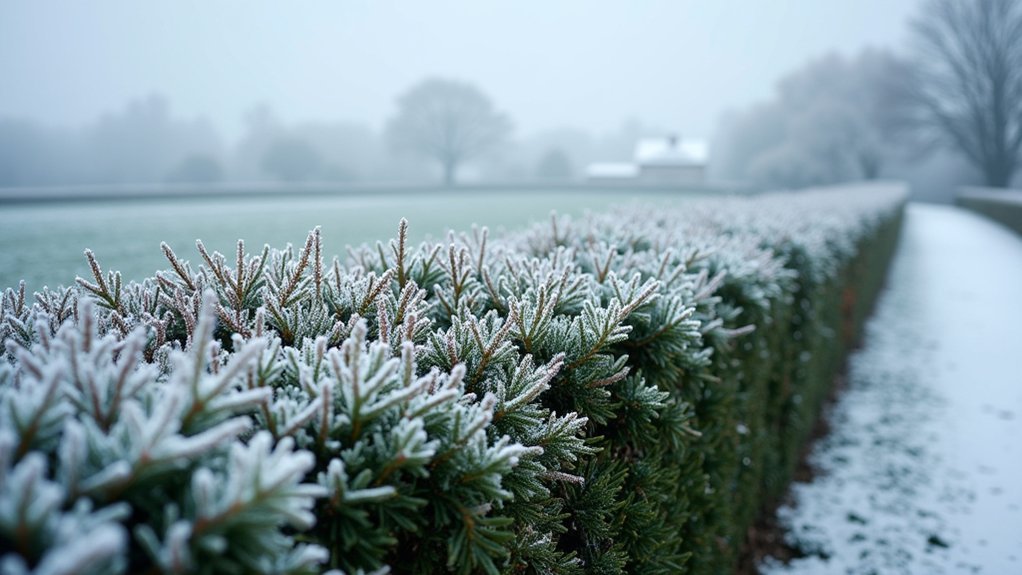For rural snowy areas, choose Thuja Green Giant or Leyland Cypress for their snow-bearing coniferous strength. Red-twig dogwood and dappled willow offer flexible branches that bend rather than break under heavy snow. Native options like winterberry and serviceberry provide superior resilience while attracting wildlife. Regular pruning and strategic positioning away from direct snowfall paths will maximize your hedge’s winter survival. Discover how these hardy varieties can transform your property boundaries while standing strong against winter’s worst.
5 Second-Level Headings for “5 Tough Hedges That Survive Rural Snow”

When planning your content about snow-resistant hedges, it’s essential to structure your article with clear, informative headings that guide readers through your recommendations.
Consider organizing your piece around these five key sections:
Organize your hedge guide around these core sections to give readers both practical solutions and aesthetic inspiration for winter protection.
- “Cold Weather Champions: Hedges That Embrace Winter”
- “Dense Foliage Defenders: Natural Windbreaks for Your Property”
- “Low-Maintenance Options for Busy Rural Homeowners”
- “Soil Adaptability: Hedges That Thrive in Challenging Landscapes”
- “Year-Round Beauty: Hedges That Look Stunning Even Under Snow”
Each heading highlights a specific benefit rural gardeners seek when selecting hedges.
This structure allows you to address both practical concerns (cold weather resilience, maintenance requirements) and aesthetic considerations while guiding readers through their options.
You’ll help them identify which hedge varieties offer the dense foliage for protection they need in harsh winter conditions.
Coniferous Champions: Evergreen Barriers for Heavy Snowfall
Now let’s examine the true winter warriors of rural landscapes.
Coniferous hedges like Thuja Green Giant and Leyland Cypress stand tall against brutal winter conditions, maintaining their structure even under heavy snowfall. Their dense foliage creates effective barriers against howling winds and muffles sound during winter storms.
For extreme cold regions, Emerald Green Arborvitae offers exceptional frost tolerance while providing superior protection for your property.
Cupressocyparis varieties develop impressive height and width when given space, creating natural snow barriers.
Dense Deciduous Options: Flexible Hedges That Bounce Back

Unlike their evergreen counterparts, deciduous hedges offer remarkable flexibility during heavy snowfall events. Varieties like red-twig dogwood and dappled willow feature flexible branches that bend rather than break under heavy snow loads, making them ideal for rural settings.
You’ll appreciate how these dense deciduous hedges deliver visual interest throughout the seasons—vibrant stems stand out dramatically against winter snow, while spring brings beautiful blooms from options like saskatoon berry and Japanese cherry.
For maximum resilience, implement regular pruning to encourage denser growth patterns. This maintenance not only enhances the hedge’s structural integrity but also improves its ability to bounce back after heavy snowfalls.
Their adaptability to various soil conditions further guarantees these hedges will thrive despite challenging rural weather patterns.
Native Selections: Region-Specific Hedges for Extreme Winters
In regions where winter shows no mercy, native hedging plants offer superior resilience against harsh conditions while supporting local ecosystems.
These adapted varieties thrive where others fail, creating living boundaries that withstand punishing snow loads and freezing temperatures.
Native hedging triumphs in winter’s harshest grip, establishing resilient natural borders where imported varieties surrender.
Consider these stellar performers for your rural property:
- Cornus sericea (red osier dogwood) – delivers stunning red stems against white snow while exhibiting exceptional hardiness against frost.
- Ilex verticillata (winterberry) – provides vibrant berries that persist through winter, feeding wildlife when food is scarce.
- Amelanchier alnifolia (serviceberry) – offers multi-season interest with spring flowers, summer berries, and brilliant fall color.
- Local varieties native to your specific region – require minimal maintenance and naturally resist pests common to your area.
You’ll create a sustainable boundary that connects your landscape to the broader local ecosystems.
Maintenance Strategies for Snow-Resistant Rural Boundaries

While establishing the right hedge varieties lays the foundation for snow-resistant boundaries, proper maintenance determines their long-term success against winter’s assault.
Regular pruning of hardy varieties like Escallonia iveyii and Photinia robusta maintains their density, enabling them to better support snow and ice without breaking.
Position your hedges strategically away from direct snowfall paths to minimize damage.
Before winter sets in, apply a protective layer of mulch around the base to insulate roots and prevent soil freezing. Additionally, implement a late fall watering regimen to adequately hydrate plants before ground freeze.
For maximum resilience, select naturally snow-resistant options such as Ligustrum undulatum and Buxus sempervirens.
These maintenance strategies guarantee your rural boundaries remain intact and attractive despite heavy seasonal snow loads.
Frequently Asked Questions
What Is the Most Hardy Hedge?
The most hardy hedge is Thuja Green Giant or Emerald Green Arborvitae. You’ll find these exceptionally cold-tolerant options withstand heavy snowfall and frost. If you’re in very cold areas, they’re your best choice.
Can Hedges Survive Winter?
Yes, hedges can survive winter. You’ll find that properly selected varieties, like Emerald Green Arborvitae and Buxus, thrive in cold conditions when you’ve provided adequate fall watering and protection from salt damage.
What Hedge Stays Green in Winter?
You’ll find several hedges that stay green in winter. Consider English Box, Photinia robusta, Cherry Laurel, Box Leaf Privet, or Escallonia iveyii. They’re all evergreen options that maintain their foliage during colder months.
What Is the Toughest Evergreen?
The Emerald Green Arborvitae is your toughest evergreen option. You’ll appreciate its exceptional cold hardiness and ability to maintain structure even in harsh winters without damage, outlasting many other varieties.
In Summary
You’ll find these five hedge options transform your rural property’s boundaries, even in the harshest winter conditions. When you’re selecting and maintaining snow-resistant hedges, prioritize your specific climate zone and soil conditions. With proper spacing, regular pruning, and patience during establishment years, you’ll create lasting, beautiful barriers that stand strong against heavy snow while providing wildlife habitat and year-round privacy.





Leave a Reply